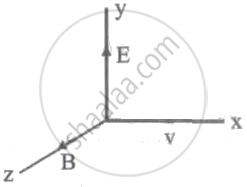Advertisements
Advertisements
प्रश्न
A charged particle would continue to move with a constant velocity in a region wherein ______.
- E = 0, B ≠ 0.
- E ≠ 0, B ≠ 0.
- E ≠ 0, B = 0.
- E = 0, B = 0.
पर्याय
a and c
b and d
a, b and d
c and d
उत्तर
a, b and d
Explanation:
This problem is based upon the single moving charge placed with some uniform electric and magnetic fields in space. Then they experience a force called Lorentz force is given by the relation Fnet = qE + q(v × B).
Force experience by the charged particle due to electric field Fe = qE
Force experience by the charged particle due to magnetic field, Fm = q(v × B)
According to the problem, particle is moving with constant velocity means the acceleration of particle is zero and also it is not changing its direction of motion.
This will happen when the net force on particle is zero.
- if E = 0, and v || B, then Fnet = 0.
- if E ≠ 0, B ≠ 0 and E, v and B are mutually perpendicular.
- When both E and B are absent.
APPEARS IN
संबंधित प्रश्न
Deduce the expression for the magnetic field at a point on the axis of a current carrying circular loop of radius ‘R’ distant ‘x’ from the centre. Hence, write the magnetic field at the centre of a loop.
A long straight wire carries a current of 35 A. What is the magnitude of the field B at a point 20 cm from the wire?
Which of the following particles will experience maximum magnetic force (magnitude) when projected with the same velocity perpendicular to a magnetic field?
A conductor has three segments; two straights of length L and a semicircular with radius R. It carries a current I What is the magnetic field B at point P?

The force between two parallel current-carrying conductors is F. If the current in each conductor is doubled, then the force between them becomes ______
A particle with charge q moves with a velocity v in a direction perpendicular to the directions of uniform electric and magnetic fields, E and B respectively, which are mutually perpendicular to each other. Which one of the following gives the condition for which the particle moves undeflected in its original trajectory?

A proton enters into a magnetic field of induction 1.732 T, with a velocity of 107 m/s at an angle 60° to the field. The force acting on the proton is e = 1.6 × 10-19 C, sin 60° = cos 30° = `sqrt3/2`
In the product `vec"F" = "q" (vec"υ" xx vec"B")`
= `"q" vec"υ" xx ("B"hat"i" +"B"hat"j" + "B"_0hat"k")`
For q = 1 and `vec"υ" = 2hat"i" + 4hat"j" + 6hat"k"` and
`vec"F" = 4hat"i" - 20hat"j" + 12hat"k"`
What will be the complete expression for `vec"B"`?
A unit vector is represented as `(0.8hat"i" + "b"hat"j" + 0.4hat"k")`. Hence the value of 'b' must be ______.
